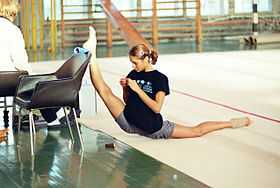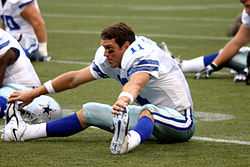Flexibility (anatomy)


Flexibility or limberness refers to the range of movement in a joint or of joints, and length in muscles that cross the joints. Flexibility varies between, particularly in of differences in muscle length of multi-joint muscles. Flexibility in some joints can be increased to a certain degree by exercise, with stretching a common exercise component to maintain or improve flexibility.
Quality of life is enhanced by improving and maintaining a good range of motion in the joints. Overall flexibility should be developed with specific joint range of motion needs in mind as the individual joints vary from one to another. Loss of flexibility can be a predisposing factor for physical issues such as pain syndromes or balance disorders.
Gender, age, and genetics are important for range of motion. Exercise including stretching often improves flexibility.
Many factors are taken into account when establishing personal flexibility: joint structure, ligaments, tendons, muscles, skin, tissue injury, fat (or adipose) tissue, body temperature, activity level, age and gender all influence an individual's range of motion about a joint.
Individual body flexibility level is measured and calculated by performing a sit and reach test, where the result is defined as personal flexibility score.
Anatomical Elements of Flexibility
Joints

The joints in a human body are surrounded by synovial membranes and articular cartilage which cover, cushion and nourish the joint and surfaces of each .[1] Increasing muscular elasticity of the joint’s range of mobility increases flexibility.
Ligaments
Ligaments are composed of two different tissues: white and yellow. The white fibrous tissues are not stretchy, but are extremely strong so that even if the bone were fractured the tissue would remain in place. The white tissue allows subjective freedom of movement. The yellow elastic tissue can be stretched considerably while returning to its original length.
Tendons
Tendons are not elastic and are even less stretchy. Tendons are categorized as a connective tissue. Connective tissue supports, surrounds, and binds the muscle fibres. They contain both elastic and non-elastic tissue.
Areolar Tissue

The areolar tissue is permeable and is extensively distributed throughout the body. This tissue acts as a general binder for all other tissues.[2]
Muscle Tissue
Muscle tissue is made of a stretchy material. It is arranged in bundles of parallel fibres.[3]
Stretch Receptors
Stretch receptors have two parts: Spindle cells and Golgi tendons. Spindle cells, located in the center of a muscle, send messages for the muscle to contract.[4] On the other hand, Golgi tendon receptors are located near the end of a muscle fiber and send messages for the muscle to relax. As these receptors are trained through continual use, stretching becomes easier. When reflexes that inhibit flexibility are released the splits then become easier to perform. The splits use the body’s complete range of motion and provide a complete stretch.
Stretching

Flexibility is improved by stretching.[5] Stretching should only be started when muscles are warm and the body temperature is raised. To be effective while stretching, force applied to the body must be held just beyond a feeling of pain and needs to be held for at least ten seconds. If held too long, the muscle will become too loose and stretchy. Increasing the range of motion creates good posture and develops proficient performance in everyday activities increasing the length of life and overall health of the individual.[6]
Dynamic
Dynamic flexibility is classified as the ability to complete a full range of motion of a joint. It also controls movement as the speed increases while stretching parts of the body. This form of stretching prepares the body for physical exertion and sports performance. In the past it was the practice to undertake static stretching before exercise. Dynamic stretching increases range of movement, blood and oxygen flow to soft tissues prior to exertion. Increasingly coaches and sports trainers are aware of the role in dynamic stretching in improving performance and reducing the risk of injury.
Static-Active

Static-active stretching includes holding an extended position with just the strength of the muscles such as holding the leg in front, side or behind. Static-active flexibility requires a great deal of strength, making it the hardest to develop.
Ballistic
Ballistic stretching is separate from all other kind of stretching. It does not include stretching or any kind of bouncing motion. The actual performance of ballistic movements prevents lengthening of tissues. These movements should only be performed when the body is very warm; otherwise they can lead to injury.
Limits of Flexibility
Each individual is born with a particular range of motion for each joint in their body. In the book Finding Balance by Gigi Berardi, the author mentions three limiting factors: Occupational demands, movement demands and training oversights.[7]
Internal Factors of Flexibility

Movement demands include strength, endurance and range of motion. Training oversights occurs when the body is overused.[8] Internally, the joints, muscles, tendons, and ligaments can affect one’s flexibility. As previously mentioned, each part of the body has its own limitations and combined, the range of motion can be affected. The mental attitude of the performer during the state of motion can also affect their range.
External Factors of Flexibility
Externally, anything from the weather outside to the age of the performer can affect flexibility. General tissues and collagen change with age influencing the individual. Young performers should be aware of over-stretching. Even basic things such as clothing and equipment can affect a performance. Dance surfaces and lack of proper shoes can also affect a performer’s ability to perform at his/her best.[9]
Signs of Injury
Stretching for too long or too much can give way to an injury.[10] For most activities, the normal range of motion is more than adequate. Any sudden movements or going too fast can cause a muscle to tighten. This leads to extreme pain and the performer should let the muscle relax by resting.
Risk of Injury

See also
- Dance
- Physical Exercise
Notes
- ↑ Blakey, WP. "Stretching without Pain." p. 9
- ↑ Blakey, WP. "Stretching without Pain." p. 26
- ↑ Blakey, WP. "Stretching without Pain." p. 30
- ↑ Blakey, WP. "Stretching without Pain." p. 33
- ↑ Ashley, Linda. "Essential Guide to Dance." p. 14
- ↑ Barratt, Marcia. "Foundations For Movement." p. 27.
- ↑ Berardi, Gigi. "Finding Balance." p. 35.
- ↑ Berardi, Gigi. "Finding Balance." p. 37.
- ↑ Berardi, Gigi. "Finding Balance." p. 34.
- ↑ Blakey, WP. "Stretching without Pain." p. 20
Bibliography
- Arnheim, Daniel D. Dance Injuries: Their Prevention And Care. 3rd ed. Princeton, NJ: Princeton Book Company, 1991. Print.
- Ashley, Linda. Essential Guide to Dance. 2nd ed. London: Hodder & Stoughton, 2004. Print.
- Barratt, Marcia, et al. Foundations For Movement. Dubuque, IA: Wm. C. Brown Co., 1964. Print.
- Berardi, Gigi. Finding Balance. 2nd ed. Routledge, NY: Routledge, 2005. Print.
- Blakey, W P. Stretching Without Pain. Canada: Twin Eagles Educational & Healing Institute, 1994. Print.
- Como W. Raoul Gelabert’s anatomy for the dancer with exercises to improve technique and prevent injuries. New York: Danad, 1964; 51-57.
- Dilmen, Nevit. Stretching. 2009. Own Work. Wikimedia Commons. Web. 4 Dec. 2010.
- Franklin, Eric N. Conditioning for Dance. Champaign, IL: Human Kinetics, 2004. Print.
- FvS. Split, gymnastics. 2005. Own Work. Wikimedia Commons. Web. 4 Dec. 2010.
- Liedarback, “General considerations,” p. 59.
- McCharles, Rick. Gymnast jumping on beam. 2008. http://flickr.com/photos/71035721@N00/2972933329. Wikimedia Commons. Web. 4 Dec. 2010.
- Pare, Caroline. Caroline Zhang in 2008 Skate Canada International. 2008. http://everythingskating.com/. Wikimedia Commons. Web. 4 Dec. 2010.
- Reinking, Ann, and Linda Szmyd. The Dancer's Workout. London: Bantam Books, 1984. Print.
- Ryan, Allan J., and Robert E. Stephens, eds. The Healthy Dancer: Dance Medicine for Dancers. Princeton, NJ: Princeton Book Company, 1987. Print.
- Stuart Wright, Dancer’s Guide to Injuries of the Lower Extremity (New York: Cornwall Books, 1985), p. 14.
- Swischuk, Leornard E. "Doing the Splits: Heard A Pop--Cannot Walk." Pediatric emergency care 23.11 (2007): 842-3. Web. 8 Sep. 2010. <http://ovidsp.tx.ovid.com>.
External links
- NYU on Hip injuries
- CMCrossroads on Stretching
- Mayo Clinic on Stretching
- How to stretch
- About.com on Front Splits
| |||||||||||